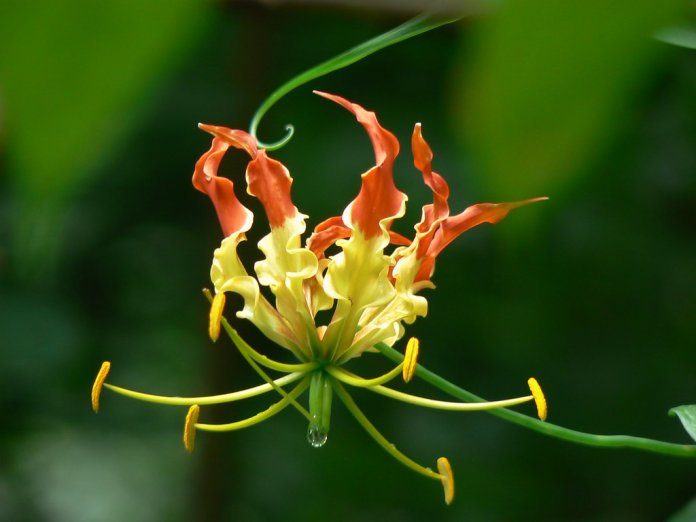Gloriosa superba is an important medicinal plant in Asia and Africa. It is used in diseases and is in high demand in pharma industries as this is a source of colchicines and colchicocides, which are very costly. Due to the unnecessary use of the plant for various medicinal purposes, the species is on the edge of extinction and is included in the list of Red Data Books.
The strenuous efforts of botanists, biotechnologists, policymakers, and conservationists are required. It is a matter of great concern to conserve this plant otherwise we will be losing in the future. The present review is focused on the current status of the genus, source of alkaloids, poisonous nature, the strategies for its conservation, and future perspectives of G. Superba.

Gloriosa superba is a commercially imperative medicinal plant that has diverse medicinal applications and eventually, due to over-exploitation, this plant is facing local extinction. It has been affirmed as an endangered plant by IUCN and hence there is a pressing need to conserve the plant by in situ and ex-situ multiplication in general and micropropagation in particular to meet the ever-increasing demand from the industries.
Besides many hybrids, popular garden cultivars like the purple prince, African chief, orange gem, orange gift, lavender lady, and orange balls are grown for an ample range of flowers and the color combination of the perianth, which bloom for a long during the autumn. G. Superba is also known as the national flower of Zimbabwe.
Except for diverse pharmaceutical products and other therapeutic preparations, it is also a popular plant for providing color in greenhouses and conservatories even immature flowers are gorgeous to behold.
Furthermore, responsiveness should be generated among the common people concerning the importance of G.superba and its overexploitation by the people. People’s participation in the conservation of rare and endangered medicinal plants. Superb will also be very useful. It is known to ancient medical writers in Sanskrit as “Gharbha ihatin” which causes absorption.
This plant grows wild in all parts of Sri Lanka and India. Sunbirds and butterflies The tubers of Gloriosa Superba closely resemble the yams of the sweet potato. These tubers have been analyzed and found to contain the alkaloids gloriosine and colchicine, and other substances – organic acids like salicylic acid and resins.

Gloriosa Superba is also known as the flame lily, tiger claw, climbing lily, gloriosa lily, fire lily, creeping lily, Agni Shikha, and glory lily. It is a species of flowering plant in the family of “Colchicaceae”.
Flame lily, is used in the treatment of many diseases. Like, infertility, itching, ulcers, gout, nocturnal emission, snakebite, colic, arthritis, sprains, kidney problems, bruises, cancer, open wounds, impotence, laxative, and an alexiteric, cholera, sexually transmitted diseases, leprosy, smallpox, antipyretic, hemorrhoids, different types of internal parasites. Its sap is used to treat acne and head lice. Moreover, during childbirth, its rhizome is used to reduce labor pain.
Colchicine was used to obtain polyploids from Datura stramonium by treating its seeds with the alkaloid. Fresh extracts of tubers of Gloriosa superba when applied to maize seed before sowing caused tetraploid sectors in developing roots. When colchicine was being extracted from Gloriosa superba the isolation of a new alkaloid, provisionally named gloriosine. Both colchicine and gloriosine have an anti-mitotic effect, and that gloriosine was found to be more effective than colchicine in polyploid
Colchicine has been used in the treatment of gout for many years. It has also been used as a cytotoxic drug in the treatment of inoperable carcinoma. Therefore, because of its fairly wide use in therapy, experiments have been conducted mainly on mice, rats, and sheep with the aim of discovering its action and toxicity. Colchicine is rapidly excreted in bile and directly into the intestine for only a brief period after administration. And after 16 hours 50% of it has been recovered.
Alopecia caused by treatment with colchicine has been known and reported on many occasions. Gloriosa superba usually multiplies by corm and seeds but due to low germination capability, it restricts regeneration. Therefore, to safeguard and preserve this important plant biotechnological approaches would be very useful. Colchicine which is a major component of Gloriosa is mainly responsible for the toxic effect.
The toxins present have an inhibitory action on cell division and depressant action on the bone marrow. Just after ingestion of tubers, the symptom develops within two hours; vomiting, numbness, and severe effects on the throat as well as diarrhea leading to dehydration. Alopecia and dermatitis are the major symptoms that develop after two to three weeks after the poisoning.
Colchicine poisoning following ingestion of G. Superba tubers has been reported by various investigators. The toxicity symptoms as gastroenteritis, acute renal failure, cardiotoxicity, and hematological abnormalities. Moreover, deaths can happen due to G. Superba, while gastrointestinal symptoms along with sweating, hypotension jaundice, and convulsions after the consumption.
